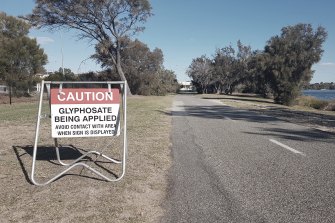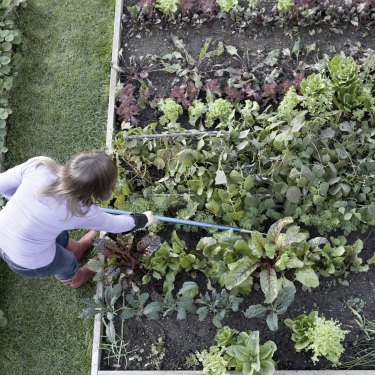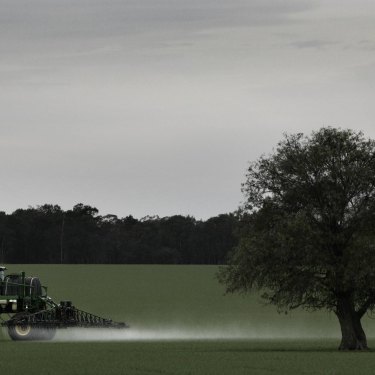Australia joins the list of countries where legal action is being pursued against Bayer-Monsanto over Roundup.
Other Countries:
. . . some local governments have stopped using it altogether. Germany has banned it from 2023 – a date that environment minister Svenja Schulze said was “as early as European law allows”. . . .
Austria outlawed it in July (2019) and a group of mayors in France have ditched it too. When the European Union sought to extend its use for five years from 2017, French President Emmanuel Macron instead pledged to ban it within three years, although he later said that a total ban would not be possible in that timeframe. France will cut glyphosate use by 80 per cent by 2021, with 10 per cent of farmers being granted an exemption. Italy is restricting its use too.
Sydney Morning Herald, By Darren Gray
Should you really be worried about using Roundup?
If you’re a gardener or a farmer, you may well have weedkiller on your property. And, whether it’s in a spray bottle you bought at a hardware store or in a large drum from a farm supplier, it may well contain glyphosate, the biggest-selling herbicide in the world. The brand name might even be Roundup.
Farmers say glyphosate is cheap, safe to use (when you follow the instructions) and works. It slashes farmers’ diesel bills because they don’t need to plough their paddocks repeatedly to kill weeds, and it helps protect soil moisture levels.
Farmers knock out weeds in order to grow better and bigger crops – weeds compete for moisture and nutrients in the soil, and for sunlight. Gardeners must dodge their wanted plants and make sure glyphosate touches weeds only.
Domestic gardeners use hand-held pumps to dispense glyphosate on to weeds while people with bigger gardens or in commercial horticulture operations might dispense it from a knapsack worn on their back.
On broadacre grain farms, it is typically dispensed by boom sprays towed by tractors and might be used months or days before grain crops are sown. In some cases, it is also used by local councils and other land managers to kill weeds on public land.
Where did glyphosate come from?
Glyphosate was developed in the early 1970s by US company Monsanto, with Roundup sold from the mid-70s. Roundup came off patent in about 2000 and many other herbicide manufacturers started making their versions. Bayer is today the owner and manufacturer of Roundup. The German-headquartered, global pharmaceutical and agricultural company acquired the brand in 2018, when it bought Monsanto for $US63 billion ($A93 billion). With this purchase, it has inherited an ongoing legal headache.
One of the Australian suppliers of glyphosate herbicides is Nufarm. The company warned in June that it was at risk of litigation because it was a supplier of glyphosate-based herbicides and, on September 30, told investors that the chemical continued to be under “intense legal and community pressure”.
But Nufarm CEO Gregg Hunt said he had been reassured by the US Environmental Protection Agency’s position released in April that there was no causal link between glyphosate and cancer. He said the chances of Nufarm being involved in any legal action was “very low” because it only had a very small market share in the US compared to industry leader Monsanto.
How is it used?
But the chemical is facing huge challenges around the world.
In the United States, courts have been asked to consider claims from thousands of plaintiffs who blame their non-Hodgkin lymphoma (a cancer that begins in the lymphatic system) on glyphosate-based weedkillers made by US company Monsanto – particularly, Roundup. In three cases so far, cancer sufferers have been awarded vast sums in damages.
In Australia, the first such claim for damages was lodged with Supreme Court of Victoria this year and a second action is set to be launched.
Victoria’s environment department recently reviewed the use of glyphosate weedkillers on public land. The review found that it was safe for such products to continue being used, as long as proper safety protocols and internal procedures were followed. A department spokesperson said that this advice was supported by “WorkSafe Victoria, the workplace health and safety regulator in Victoria”.
However some local governments have stopped using it altogether. Germany has banned it from 2023 – a date that environment minister Svenja Schulze said was “as early as European law allows”.
So precisely what is glyphosate and should we be concerned?
What is glyphosate and how does it work?
Glyphosate is a synthetic chemical that combines aspects of two naturally occurring types of chemicals – phosphates and amino acids – in a liquid form to deadly effect on plants. Also in the mix is a surfactant, a form of detergent, which dissolves the wax on leaves and enables the chemical to get into the plant’s internal mechanisms, says Adelaide University molecular pharmacologist/toxicologist Ian Musgrave.
Dr Musgrave says glyphosate inhibits something in plants known as the shikimic acid pathway, an enzyme pathway found only in plants and some bacteria.
“Two things happen. They can’t make proteins any more, and they can’t make an essential vitamin any more and so that means they can’t grow and then eventually curl up and die,” he says.
Glyphosate doesn’t kill plants immediately, says Ian Rae, honorary professorial fellow in chemistry at the University of Melbourne. Instead, it is “more deep-seated”.
“It gets into the plant’s system and kills it.”
Farmers knock out weeds in order to grow better and bigger crops – weeds compete for moisture and nutrients in the soil, and for sunlight. Gardeners must dodge their wanted plants and make sure glyphosate touches weeds only.
Domestic gardeners use hand-held pumps to dispense glyphosate on to weeds while people with bigger gardens or in commercial horticulture operations might dispense it from a knapsack worn on their back.
On broadacre grain farms, it is typically dispensed by boom sprays towed by tractors and might be used months or days before grain crops are sown. In some cases, it is also used by local councils and other land managers to kill weeds on public land.
This man with cancer received a huge payout from Bayer. Watch a judge deliver the US court’s decision.
The 2 minute video won’t copy. My posting about “this man with cancer” is at
Weeds are annoying. What’s the harm in it?
In the United States, courts have ordered Bayer to pay damages to three plaintiffs, including $US289 million ($426 million) to the first plaintiff, Dewayne Johnson, a school groundskeeper suffering from non-Hodgkin lymphoma. Bayer has appealed the Johnson decision, and signalled it will appeal the other two.
In Melbourne, a landscape gardener who has non-Hodgkin lymphoma and who was explosed to glyphosate over 20 years, has started legal action against Monsanto. In a Supreme Court writ filed in March, Carbone Lawyers claimed Monsanto “knew or ought to have known that the use of Roundup products were dangerous for the plaintiff … in particular causing DNA and chromosomal damage in human cells, cancer, kidney disease, infertility and nerve damage among other devastating illnesses.”
Carbone Lawyers was also set to launch proceedings in a second case.
The effects of glyphosate on humans are not the only concern. Germany will limit its use before its ban kicks in, along with limitations on the use of pesiticides, as part of its Action Programme for Insect Protection. The government says these chemicals kill bees and other insects, which are critical to the natural ecosystem.
The ban has been opposed by farm groups and the German Chemical Industry Association has accused the government of “embarking on a confrontation course with European law”.
Bayer says the ban ignores “the overwhelming scientific assessments of competent authorities around the world that have determined for more than 40 years that glyphosate can be used safely”.
But Germany is not the first European nation to ban glyphosate – Austria outlawed it in July and a group of mayors in France have ditched it too. When the European Union sought to extend its use for five years from 2017, French President Emmanuel Macron instead pledged to ban it within three years, although he later said that a total ban would not be possible in that timeframe. France will cut glyphosate use by 80 per cent by 2021, with 10 per cent of farmers being granted an exemption. Italy is restricting its use too.
Is it banned in Australia?
No, although Fairfield City Council in Sydney has phased out Roundup, while some other Sydney councils have pledged to conduct reviews. Victoria’s Moyne Council, in the state’s south-west, has stopped using Roundup alongside other herbicides. Victoria’s environment department reviewed the use of glyphosate”as a matter of precaution”.
Australian farmers and farm groups are vigorously defending glyphosate, worried about what would happen if sentiment against the product rose further and they faced added restrictions.
Graingrowers chairman Brett Hosking says glyphosate has “drastically” reduced diesel use on farms, as farmers steer away from heavy cultivation of soil.
“Glyphosate gives us the ability to still control those weeds and conserve the moisture, conserve the nutrients in the soil, but we don’t actually disturb the soil structure,” he says.
Environmentalists are calling for a ban. Anthony Amis, from Friends of the Earth, believes this will happen, in a staged approach. “The pressure is definitely building,” he says.
He has concerns about insect habitats too. He says that the spray can drift away and hit other plants in the landscape, which then die and reduce insect habitats.

A roadside in WA.Credit:Emma Young
What do regulators say?
Registered products containing glyphosate are “safe to use according to label directions”, says the Australian Pesticides and Veterinary Medicines Authority (APVMA). The authority says it has reviewed more than 1200 scientific studies from around the world on glyphosate “to ensure the accuracy of its assessment”, including a 2015 report by the International Agency for Research in Cancer (IARC), which said glyphosate was a probable carcinogen to humans.
The APVMA said it was crucial to recognise that IARC’s work was a “hazard assessment” and did “not include risk assessment and risk management”.
Farm groups and Croplife Australia, which represents agricultural chemical producers, point to the long-running US Agricultural Health Study that looked at the risk between glyphosate exposure and non‑Hodgkin lymphoma. Croplife says the US National Cancer Institute, the National Institute of Environmental Health Sciences and others have investigated data from more than 89,000 farmers and their spouses and “found no association between glyphosate and non‑Hodgkin lymphoma – regardless of the exposure level”.
In August, the US Environmental Protection Agency said it would “no longer approve product labels claiming glyphosate is known to cause cancer – a false claim”. It also said it disagreed with IARC’s assessment of glyphosate, had reviewed a more extensive dataset than IARC and determined glyphosate was “not likely to be carcinogenic to humans”.
But cancer epidemiologist Bruce Armstrong, emeritus professor University of Sydney, says he recently saw signs in Perth warning of glyphosate being used to spray weeds in public areas, including by a local council.
“I think they (local councils) should stop using it where, at the moment, there is a practical alternative,” he says. “And they need to look at all of their uses and ask the question, ‘Is there a way in which we can avoid needing to use this’?”
Are there alternatives to glyphosate?
There are alternatives, some more potent, some less. One of the more potent options, according to Dr Musgrave, is a herbicide called atrazine, which is used in Australia under “very strict restrictions”.
Mr Hosking says atrazine remains in the soil for longer than glyphosate, and doesn’t kill as broad a range of weeds.
Another option used by some home gardeners and organic farmers is steam blasted onto weeds.
At home, there’s another alternative, which is free but involves plenty of elbow grease. It’s called weeding, which is something that can be done by hand, or with the assistance of tools such as pitchforks and trowels. This is a realistic option for active home gardeners but, for those with health concerns or very large gardens, weeding may not be feasible.

